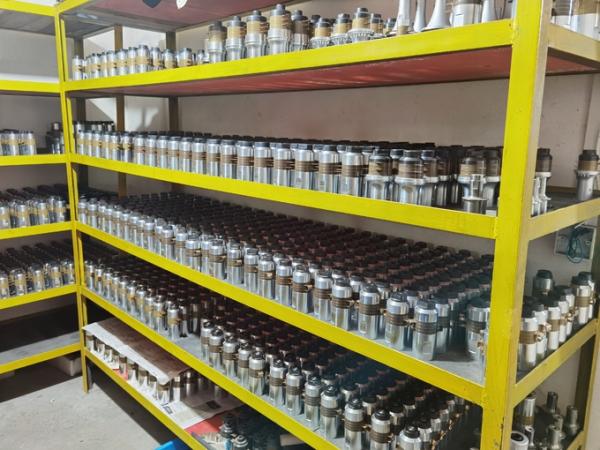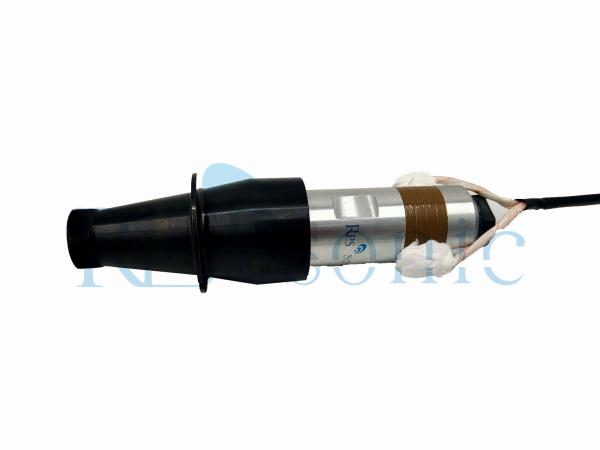| Sign In | Join Free | My chinacsw.com |
|
| Sign In | Join Free | My chinacsw.com |
|
| Categories | Ultrasonic Welding Transducer |
|---|---|
| Brand Name: | Rps-sonic |
| Model Number: | RPS-5020-4Z |
| Certification: | CE |
| Place of Origin: | China |
| MOQ: | 1pcs |
| Price: | negotiable |
| Payment Terms: | T/T |
| Supply Ability: | 200PCS/MONTH |
| Delivery Time: | 1DAYS |
| Packaging Details: | CARTON |
| Frequency: | 20Khz |
| Power: | 2000w |
| Ceramic chips: | 4PCS |
| Material: | Alumium |
| Weight: | 3.5kg |
| Application: | Ultrasonic welding |
| Capacitance: | 11000~12000PF |
| Connect Screw: | M8*1.5 |
20Khz 2000w Ultrasonic Welding Transducer For Plastic Welding Machine
20Khz 2000wUltrasonic Welding Transducer For plastic Welding machine
Parameter
| Item | Frequency | Impedance | Capacitance |
| 5020-4Z | 19.8 | 6 | 12000 |
Description
Ultrasonic transducer is a kind of energy conversion device. Its function is to convert the input electric power into mechanical power (ultrasound) and then transmit it out, and it consumes only a small amount of power.
Ultrasonic generator (also called ultrasonic power supply) converts 220V mains electricity into high-frequency current and transmits it to piezoelectric ceramics. The piezoelectric ceramics resonate at ultrasonic frequencies. The piezoelectric effect of the material converts electrical signals into linear mechanical vibrations. , And then amplify (reduce) the amplitude through the ultrasonic horn, and finally transmit it to the tool head for work. Ultrasonic transducers generally come in two forms: magnetostrictive and piezoelectric ceramics. All transducers used by our company are piezoelectric ceramics.
Magnetostriction: The effect of a material being deformed under the action of a magnetic field or a magnetic field is generated when the material is deformed. These materials usually contain nickel which exhibits strong magnetostriction. Magnetostrictive materials (usually laminated) are used in magnetostrictive sensors. Due to eddy currents, magnetostrictive transducers usually have higher losses than piezoelectric transducers and therefore have higher cooling requirements.
The composition of ultrasonic transducer
Almost all piezoelectric transducers used for power ultrasound are
of the Langevin type, that is, one or more piezoelectric ceramics
are mechanically compressed (prestressed) between the front driver
and the rear driver.
The ultrasonic transducer is mainly composed of a central piezoelectric ceramic element, front and rear metal cover plates, prestressed screws, electrode sheets and insulating tubes
Rear driver: The cylindrical element on the back of the
piezoelectric transducer. The rear driver is close to the last
piece of piezoelectric ceramic and is usually preloaded by stacking
bolts.
Electrode sheet: A thin conductive disc between the piezoelectric
ceramics adjacent to the transducer. The transducer drive voltage
is applied between these electrodes.
Front drive: Transmit the ultrasonic energy of the transducer to
the horn or tool head. The front drive usually includes a mounting
flange for connecting the housing.
Prestressed screw: A single stacked bolt passes through the center
hole of the ceramic. After tightening the bolt, the ceramic will be
compressed between the rear driver and the front driver, thereby
applying the required prestress to the ceramic.
Piezoelectric ceramics: Piezoelectric ceramics is the heart of the
transducer, a component that converts the electrical signal of the
ultrasonic generator into linear mechanical vibration.
The influence of prestress on the transducer
The impedance and frequency of the piezoelectric ceramics will be
stable with the increase of the prestress. A larger prestress can
reduce the impedance of the transducer. If the piezoelectric
ceramics are not sufficiently clamped, the impedance of the
transducer will become larger.
Is the prestress of the transducer larger the better?
Excessive prestress will reduce the performance of the transducer, which is mainly reflected in the following aspects:
The performance of piezoelectric ceramics changes under the action
of compression bias. In particular, the maximum safe temperature at
which the material can work effectively may be greatly reduced, and
high compressive stress may lower the Curie temperature.
Excessive pretension will cause significant depolarization, and
will also produce unstable impedance and aging.
Excessive prestress will reduce the service life of the transducer,
and in severe cases will cause the ceramic chip of the transducer
to crystallize.
Excessive prestress of the transducer will show a smaller impedance
in the early stage, but the performance of the transducer will
decrease with the passage of time, accompanied by high-impedance
products.


|